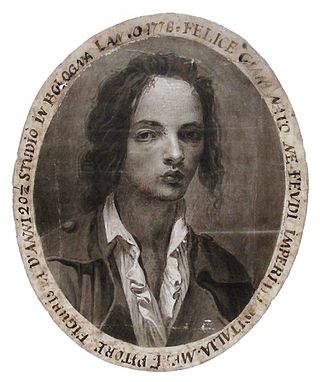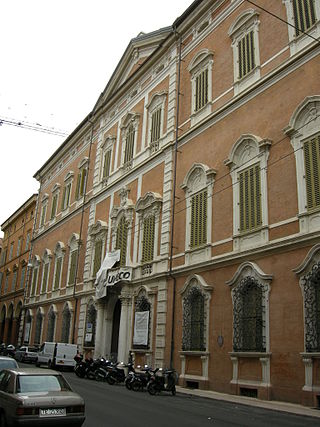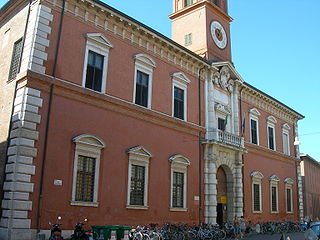Related Research Articles

Pellegrino Tibaldi, also known as Pellegrino di Tibaldo de Pellegrini, was an Italian mannerist architect, sculptor, and mural painter.

Felice Giani was an Italian painter of the Neoclassic style. His grand manner subjects often included Greco-Roman allusions or themes.

Palazzo Hercolani is a palace in Forlì, Emilia-Romagna, Italy. There is also a Palazzo Hercolani in Bologna.

Palazzo d'Accursio is a palace once formulated to house major administrative offices of the city of Bologna, region of Emilia-Romagna, Italy. It is located on the Piazza Maggiore, and is the city's Town Hall. The palace is also home to the Civic Art Collection, with paintings from the Middle Ages to the 19th century; the Museo Morandi, with the works by Giorgio Morandi; and the Biblioteca Salaborsa, the town libraries.

Palazzo Magnani is a Renaissance palace located on Via Zamboni number 20 in central Bologna, region of Emilia Romagna, Italy, built by the Magnani noble family with the same name.

The National Art Gallery of Bologna is a museum in Bologna, Italy. It is located in the former Saint Ignatius Jesuit novitiate of the city's University district, and inside the same building that houses the Academy of Fine Arts. The museum offers a wide collection of Emilian paintings from the 13th to the 18th century and other fundamental works by artists who were in some way related to the city.
Alfonso Torreggiani (1682–1764) was an Italian architect of the Rococo period, principally associated with Bologna.

The Palazzo Aldovrandi is a Senatorial palace on Via Galliera 8 in Bologna, built in Rococo style.

The Palazzo Poggi is a palazzo in Via Zamboni 33, Bologna, Italy. It is the headquarters of the University of Bologna and of the rector of the university.
Bartolomeo Triachini or Bartolomeo Tassi (1516–1587) was a Bolognese architect.

The Palazzo Pepoli Campogrande, also known as Palazzo Pepoli Nuovo, is a Baroque style palace on Via Castiglione 7 in central Bologna, region of Emilia-Romagna, Italy. In 2015, it served as a public art gallery for late-Baroque art. Across the Via, rises the medieval Palazzo Pepoli Vecchio, also once pertaining to the same family, which now serves as a museum of the history of Bologna.

The Palazzo Legnani Pizzardi, also known as Palazzo Pizzardi e Volta or just Palazzo Pizzardi, is a Renaissance style palace located on Via d'Azeglio #38, corner with Via Farini, in central Bologna, Italy. In 2015, the palace housed the Tribunal of Bologna.

Palazzo Malvezzi Campeggi is a Renaissance palace located on Via Zamboni number 22, at the corner (southwest) with Via Marsala, in central Bologna, region of Emilia Romagna, Italy. It stands across from San Giacomo Maggiore, and just northeast of the Palazzo Magnani. It presently houses the law faculty of the University of Bologna.

The Palazzo Fantuzzi is a monumental Renaissance style palace located on Via San Vitale number 23 in central Bologna, region of Emilia-Romagna, Italy. The palace is also known as the Palazzo degli Elefanti for its sculpted decoration, and it stands near the church of Santi Vitale e Agricola.
The Palazzo Leoni is a Renaissance style palace located on Via Marsala #31, in front of the outlet of Via Mentana, in central Bologna, region of Emilia-Romagna, Italy. The apse of the church of San Martino, is across the street.

The Palazzo Paradiso is a Renaissance palace located on Via Scienze #17 in the medieval center of Ferrara, region of Emilia-Romagna, Italy. Adjacent to the historic Jewish ghetto of Ferrara, it houses:
The Palazzo Zagnoni, also known as Palazzo Spada, is a Neoclassic-style palace located on Via Castiglione 25–27, in Bologna, region of Emilia-Romagna, Italy.

The Palazzo Grassi is Gothic-style, 13th-century palace located on Via Marsala #14 in Bologna, region of Emilia Romagna, Italy. The palace in 2015 houses the Circolo Ufficiali dell'Esercito, a private Officer's club.
References
- ↑ Storia e Memoria di Bologna, entry by Mara Casale.